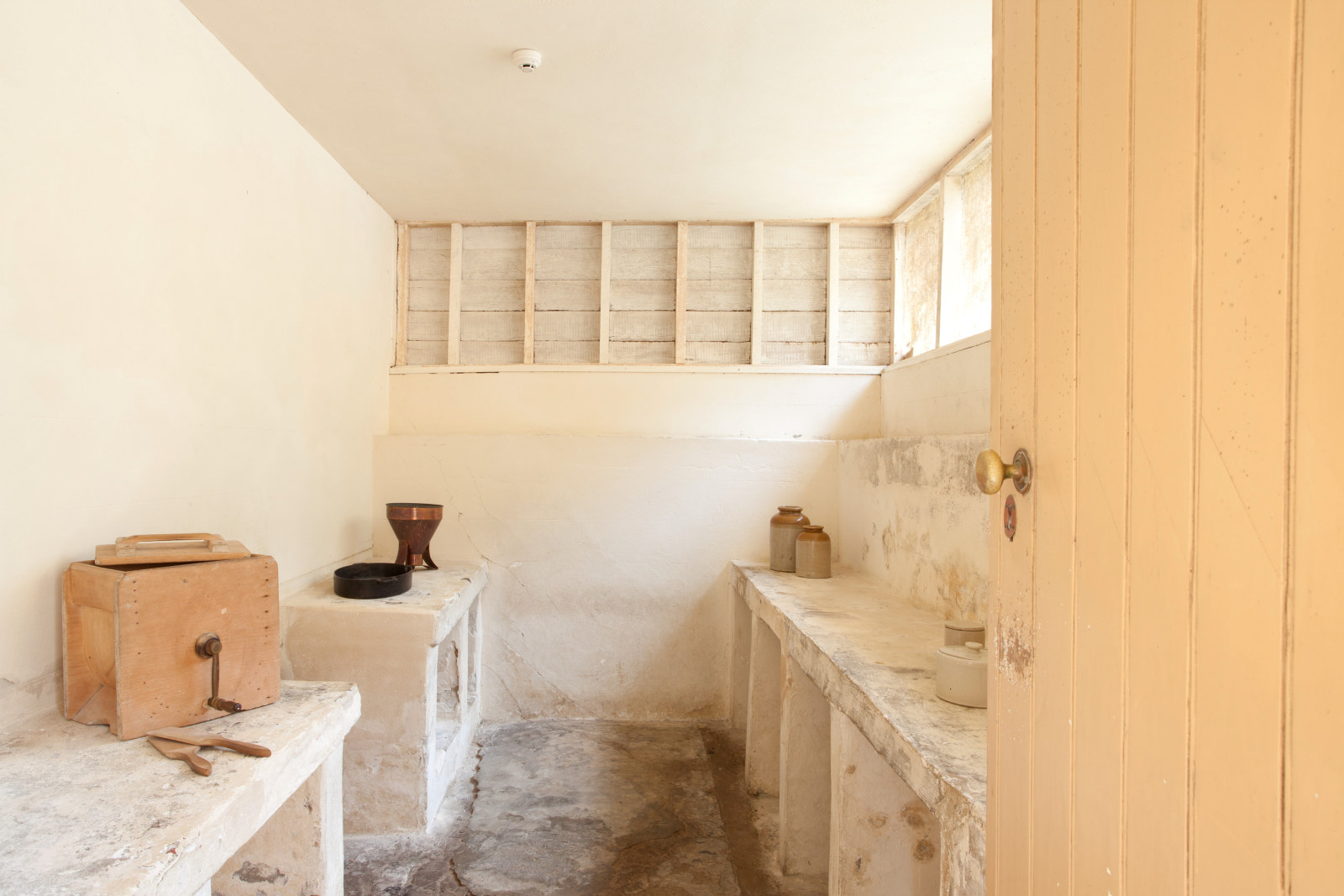Reviving Vaucluse House
Two significant projects have come to fruition at Vaucluse House. The drawing room refurbishment draws upon authentic sources and traditional trades to re-create a room that the Wentworths might have known, while the orientation room has been redesigned to enhance visitors’ understanding of the site’s complex history.
The results were unveiled in April 2017. It is through the generous financial support of the Foundation and our donors that we are able to continue our important work in preserving our heritage for future generations.
The drawing room
The drawing room – now considered one of the finest surviving colonial interiors in Australia – was built and furnished by William Charles and Sarah Wentworth in the 1840s. In 2017, we see it transformed by experts for the next generation of visitors. The refurbishment has been a labour of scholarship, dedication and care.
No pictorial evidence of the original drawing room survives, so our only snippet of information is an auction advertisement in the Sydney Morning Herald in 1853, when the family was preparing to leave Australia for England. It listed a variety of furniture for sale, comprising ottomans, sofas and easy chairs in ‘elaborately carved rosewood’ and upholstered in crimson silk damask. Without a fragment of this original upholstery, we worked with Richard Humphries from Humphries Weaving in Suffolk, England, to source damask of an appropriate design, colour and quality.
As a significant original finish, the colour and design of the floral wallpaper frieze was an important reference point and guided the decision-making process. Midway through 2016, over 200 metres of this splendid custom-woven crimson damask was shipped to Sydney. The furniture – including two single-ended sofas, stools, a pair of ottomans and five Wentworth-provenanced chairs – was expertly reupholstered by Carlos Rodrigues. Conservator Ben Stoner treated much of the furniture, including re-carving a section of rosewood previously lost from one of the single-ended sofas. The window furnishings were created by Chrissie Jeffery, creative director of Stitches Soft Furnishings, and her talented team, using 19th-century sources and with input from architecture and interiors specialist Dr James Broadbent AM.
Essential to any historical furnishings project are the passementeries, or trimmings – bullion fringes, ropes, gimp, hangers and tassels. Some of the trimmings for this project were imported from France, while many others were custom-made for us by artisan Morrison Polkinghorne in Cambodia. The tassels for the box ottomans were meticulously copied from an example in the Caroline Simpson Library & Research Collection. Our Soft Furnishings Group of volunteers painstakingly hand-stitched silk hangers into the wool bullion fringe for the window furnishings.
Orientation room
Another exciting interpretation project is the creation of a display, orientation and rest area for visitors. The ground floor room, which may have been Wentworth’s estate office, has been redesigned to share the stories of the site, from its enduring Aboriginal connections, its ownership by Sir Henry Browne Hayes and occupation by the Wentworth family to its transfer into public ownership and the creation of a museum, including the important role played by Sydney Living Museums (now Museums of History NSW). The multi-layered display is a mix of bespoke joinery, interpretative panels and audiovisual components.
Rarely seen treasures
The refurbished orientation space has given us the opportunity to conserve and display rarely seen treasures from the Vaucluse House collection. Objects once belonging to the Wentworth family jostle with more idiosyncratic material from the property’s early museum phase. A selection of these objects appears below.
William Charles Wentworth’s bicorne hat, London, c1855, black silk with marcasite and cut and polished steel decoration.
This bicorne – literally ‘two-horned’ – hat was part of the court dress made for Australian politician William Charles Wentworth (1790–1872) while he was on an extended visit to England and Europe in 1854–61. Wentworth’s activities during this time included lobbying to secure the introduction into the British Parliament of a Constitution Bill which would provide full responsible government for the colony of NSW. It’s presumed that it was in connection with his lobbying that Wentworth commissioned a full court dress for himself. A bicorne hat was designed to be folded flat so that it could be conveniently tucked under the arm when not being worn.
Gift of The Hon William Charles Wentworth IV, AO and the Wentworth family, 1991
Sarah Wentworth’s dress fan, France, c1860, painted paper, mother-of-pearl, gilt metal.
This highly decorative pleated fan, with hand-painted and gilded paper leaf and pierced and carved mother-of-pearl guards and sticks, is a dress fan, an item of costume carried by fashionable ladies from the 16th century until the late 19th century. It was part of the estate of Miss Dorothy Wentworth (1873–1956), granddaughter of William Charles and Sarah Wentworth, and was one of many items inherited by Miss Wentworth from her grandparents’ household at Vaucluse House. It’s believed to have been acquired by Sarah Wentworth during the period 1853–61 when the family were living in England and on the Continent.
Gift of Mrs Joan Wentworth Weekes, 1980
J D Pinnock’s shirt stud, England, 1839, gold, rubies, human hair.
This tiny item of men’s jewellery, less than 1.5 centimetres in diameter, contains a strand of human hair, held within a channel running through the coils of the ruby-eyed serpent. It’s said to have been ‘Miss Wentworth’s hair’ and to have been one of three shirt studs given to colonial civil servant James Denham Pinnock (1810–1875) in 1839. ‘Miss Wentworth’ was probably one of the daughters of D’Arcy Wentworth (1762–1827), the founder of the Wentworth dynasty in Australia, but the details of her connection to Mr Pinnock are unknown. The gold stud itself is highly symbolic, with the serpent representing undying love and the rubies standing for passion. The inclusion of a thread of hair makes this an emotionally charged item of jewellery.
Gift of Sir Kenneth Whistler Street, 1964
Snuffbox, England, mid-19th century, papier-mâché.
This circular box was given to the trustees of Vaucluse Park in the 1930s or 1940s as a curiosity. The box had been found floating on Sydney Harbour by a man named John Fraser; it was able to survive its watery adventure because it’s made of a durable form of papier-mâché, and is also insulated by the varnish applied to its decoration, a transfer-printed engraving depicting a hunter and his hounds. Although the taking of snuff (a finely powdered tobacco) was in decline by the mid-19th century when this box was made, the size of the box, 9.5 centimetres in diameter, suggests that it was intended for general tabletop use rather than being a prized personal possession.
Published on
Related

Conservation
Conservation in action: Vaucluse House waterfall, ponds and rill
The Vaucluse House Waterfall, Ponds and Rill Conservation Project will preserve the integrity and heritage significance of these important features of the estate. It was made possible by the generous support of the F&K De Angeli Foundation

Conservation
Conservation in action: Vaucluse House ancillary buildings remediation
Museums of History NSW (MHNSW) is currently undertaking essential conservation works on the 1830s former store, laundry and water tank at Vaucluse House

Convict Sydney
Harbourside Gothic: The convict origins of Vaucluse House
Its architectural style is not all that is gothic about Vaucluse House. Discover the dark history of the house’s first owner, Henry Browne Hayes

The coolest room in the house
What practical techniques can we learn from historical building design to minimise heat and energy consumption in our homes today?
